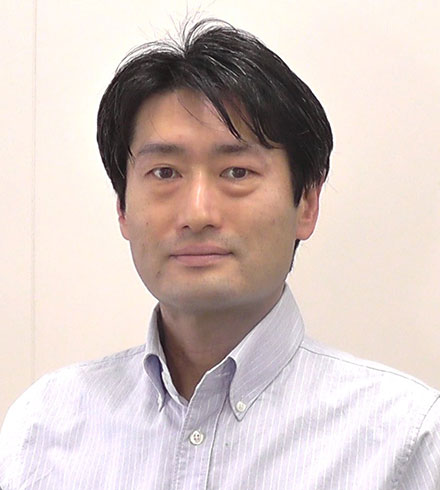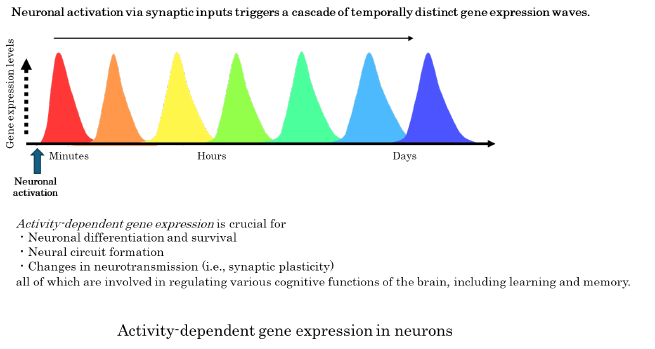Elucidating the molecular and cellular mechanisms by which neuronal activity-dependent gene expression regulates circuit reorganization and cognitive function in the brain

Project members
| NAME | OKUNO Hiroyuki |
|---|---|
| Organization | Biochemistry and Molecular Biology, Functional Biology and Pharmacology, Graduate School of Medical and Dental Sciences |
| Position Title | Professor |
| Degree | Ph.D. |
| External link | https://www3.kufm.kagoshima-u.ac.jp/biochem2/ |

| NAME | HARAGUCHI Misako |
|---|---|
| Organization | Biochemistry and Molecular Biology, Functional Biology and Pharmacology, Graduate School of Medical and Dental Sciences |
| Position Title | Associate Professor |
| Degree | Ph.D. |
| External link | https://www3.kufm.kagoshima-u.ac.jp/biochem2/ |

| NAME | KIYAMA Yuji |
|---|---|
| Organization | Biochemistry and Molecular Biology, Functional Biology and Pharmacology, Graduate School of Medical and Dental Sciences |
| Position Title | Assistant Professor |
| Degree | Ph.D. |
| External link | https://www3.kufm.kagoshima-u.ac.jp/biochem2/ |

| NAME | Takeru Suzuki |
|---|---|
| Organization | Biochemistry and Molecular Biology, Functional Biology and Pharmacology, Graduate School of Medical and Dental Sciences |
| Position Title | Specially Appointed Assistant Professor |
| Degree | Ph.D. |
| External link | https://www3.kufm.kagoshima-u.ac.jp/biochem2/ |

Background and inspiration
I was engaged in cancer research during my master’s program in graduate school. “Immediate-early genes” are a class of genes to be rapidly expressed in the nucleus, in response to various extracellular signals that induce cell proliferation. Cancer cells are originated from normal cells, but when a mutation occurs in a gene involved in cell growth, causing proliferation signals to remain constantly active, the cells begin to grow uncontrollably. By the 1980s, researchers in the field recognized that immediate-early genes such as fos, jun, and myc, which are rapidly transcribed in the nucleus upon receiving signals, play a crucial role in regulating cell growth.
One day, I came across a study reporting that immediate-early genes could also be expressed in neurons, which motivated me to pursue research in neuroscience. Unlike cancer cells, which divide, neurons are fully differentiated and do not undergo cell division. This led me to wonder why genes essential for cell division would also be present in neurons. Since neurons do not divide, I hypothesized that changes in neuronal connections, or neural circuits, might occur as a consequence of immediate-early gene expression. I was also interested in the molecular and cellular mechanisms underlying learning and memory. Therefore, from my doctoral studies onward, I pursued research on the relationship between gene expression and memory formation. Later, during my time in a research lab abroad, I became particularly interested in the Arc gene (*),which had been newly discovered in my host laboratory as a novel immediate-early gene. Since then, I have focused my research on the Arc gene.
*Arc (activity-regulated cytoskeleton-associated protein):
Arc is a neuronal immediate-early gene that is specifically expressed in response to neuronal activity. It is is dynamically regulated in the neocortex and hippocampus, and plays a crucial role in modulating neurotransmitter receptors, and thereby contributing to learning and memory.
Overview
Memory can be classified based on its duration into three different types: short-term memory, which lasts from seconds to hours; long-term memory, which persists for days to months; and long-lasting memory that can last a lifetime. Based on both clinical and basic science studies, it has been shown that these different types of memory are stored in distinct brain regions, indicating that the neural circuits responsible for memory shift over time. Neuroscientists now believe that such shift of neural circuits involves expression of a set of genes, including the aforementioned immediate-early genes, whose expression is induced by neurons that are activated during learning or memory recall. Through a comprehensive analysis of gene expression in the brain, we have identified hundreds of genes whose expression changes in a neuronal activity-dependent manner. Our research focuses on understanding how these activity-dependent genes regulate brain functions.
Furthermore, neuronal activity-dependent genes play essential roles in brain development as well as the maintenance of brain function after maturation. Clinical studies have revealed that dysregulation of their expression is associated with neurodevelopmental disorders and psychiatric diseases.

Results so far
While specific outcomes are yet to be determined and details cannot be disclosed at this stage, multiple research projects are ongoing in our laboratory. For example, we have found that the Arc gene is required for the transition from long-term memory into more persistent forms of memory. In addition, we are identifying and characterizing novel genes likely involved in the regulation of neuronal morphology and cognitive function.
Application
If pharmaceutical companies and other organizations take an interest, we believe that collaborative research could lead to interventions for enhancing cognitive function and the development of therapies for brain diseases, including depression and other mental health disorders.
